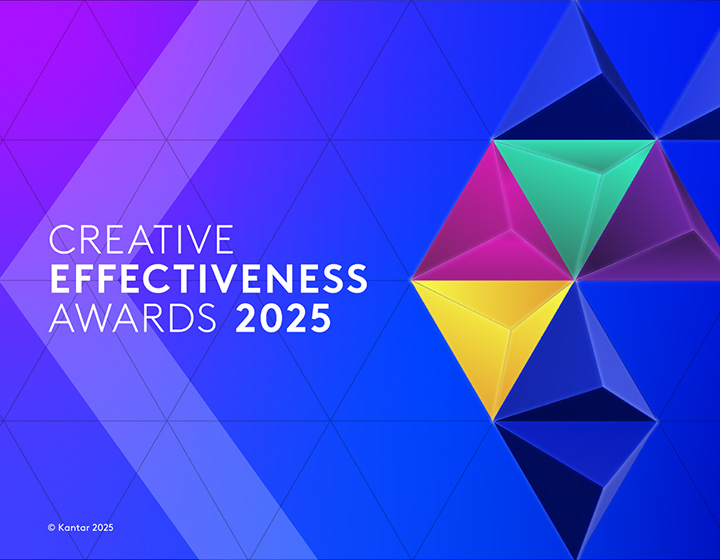What does Having It All actually mean?
There has been much debate in marketing circles on the topic of short-termism, where marketing is expected to increase sales in the short term, usually referred to as performance, sales or activation marketing (such as promotions). Short-termism has more recently been prompted by the current economic uncertainty many are experiencing, where seeing a very real sales return on restricted marketing budgets has become more important than ever. The LIONS’ State of Creativity Study 2023 points out that 48% of the global creative community is now prioritising investment in targeted promotions over brand building and customer experience. We think this is a dangerous tactic.
Longer-term strategies address a brand’s immediate and longer-term future, helping to build predisposition and ensure continued demand and brand growth. There is a need for both: they are symbiotic.
Looking back, we can see just how much advertising has evolved. Ads used to simply tell us about products, what they could do for us, and why we should buy them. See this Unilever ad for SR Gibbs toothpaste, the first ad to be shown on UK TV in 1955. But advertising is a much bigger beast now: it’s the voice of your brand - and your brand is more than just something that’s for sale.
Brands have become a part of the human experience, a part of culture, a part of the way we live, and building predisposition involves a lot more than encouraging sales today. Most importantly, brands need to stand out from their competitors and make it easy for consumers to make choices.
Brands that are aware of this and that have looked to the future in their brand building communication, such as McDonald’s, General Mills and Airbnb have seen, and continue to see, the fruit of their labours. These are brands that have become stronger. They evolve, expand and extend, and are brands that are likely to be with us in many years to come.
What are marketers thinking, and why?
Kantar’s Media Reactions study last year asked marketers which objectives are the most important measurement of ROI (performance marketing, brand building or a mixture of the two). Despite 86% of marketers believing a mix is necessary, only 63% measure the impact of their marketing campaigns using both brand and sales measures.
The creation of digital marketing initially gave a sense that anything was possible. The early digital world was a bit like the wild west. Digital advertising seemed quick and cheap compared with TV. Many thought it wasn’t worth researching because of all the new behavioural data flowing in – just count the clicks and see if sales go up. Clicks were an easy metric – with no normative data, anything was good if it did better than last time. But marketers need to beware of instant gratification.
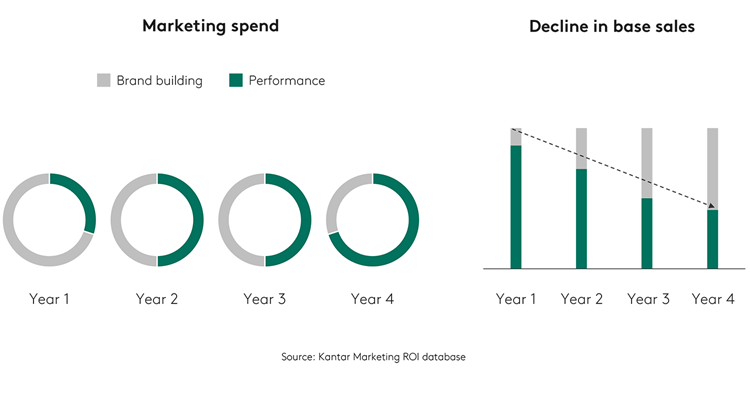
A further issue lies in marketers’ job tenure, which typically is around 2 or 3 years, but there has been further movement from short tenure to non-permanent marketing roles as interim vacancies are skyrocketing, with companies debating whether they should put money into permanent CMO positions. So along with the LinkedIn enticements of new and exciting job opportunities, people in marketing are not often going to be around to see the results of tackling the long game. This means they may feel the need to prove themselves with quick sales before moving on.
Initially, a lack of research into digital advertising and reliance on clicks for measurement could well be the reason why digital advertising evolved into a more heavily performance marketing medium, one where lower costs and faster turnarounds led to a lack of focus on the future.
Pushing the reset button
So, let’s reset this seemingly eternal debate for a digital future and lay down some facts. Any medium is capable of delivering any marketing objectives – some lean towards brand building, some lean towards performance marketing; but then it’s down to the creative.Kantar has been measuring the brand impact of digital advertising since 1996 (!), and now we have clear evidence that digital advertising is as powerful as any other medium in its ability to evoke strong emotions which we know drive brand equity. So marketers need to take stock. There is a multitude of learning out there that proves that the long game will not only enhance sales but can also grow future demand for your brand by creating predisposition. This includes digital advertising. So that’s good news, in case that new and enticing job doesn’t come to fruition!
Can you accomplish both brand building and performance marketing?
Another hotly debated topic is whether it is even possible to focus on both performance marketing and brand building in the same ad. Data in this article suggests that ads that score well on brand building will naturally do well on activation, but not the other way round. Kantar data suggests this is only partially true. Looking at our data from ads researched over the last five years, we see that brand building and performance marketing usually align.
Two-thirds (66%) of all ads perform similarly on both, with very few doing extremely well on either measure, but not on the other.
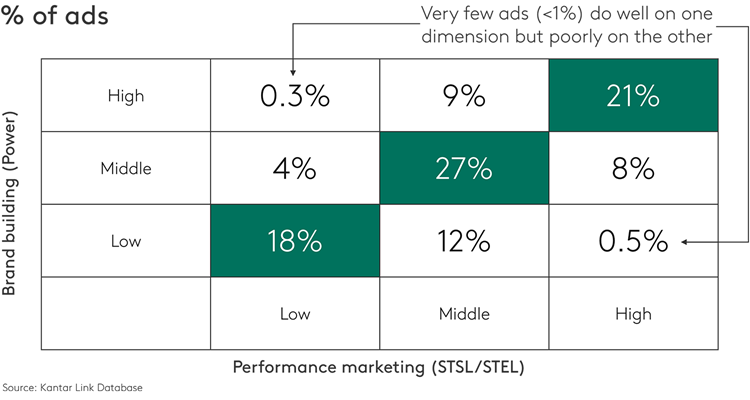
Beyond this major finding, there is some secondary evidence that moderately successful short-term ads are less likely to be good for the long-term, than moderately successful long-term ads being successful in the short-term. Brands need to keep focused on brand building when developing ads.
It’s important not to lose sight of your long-term brand objectives, even when developing ads designed to work in the short term.
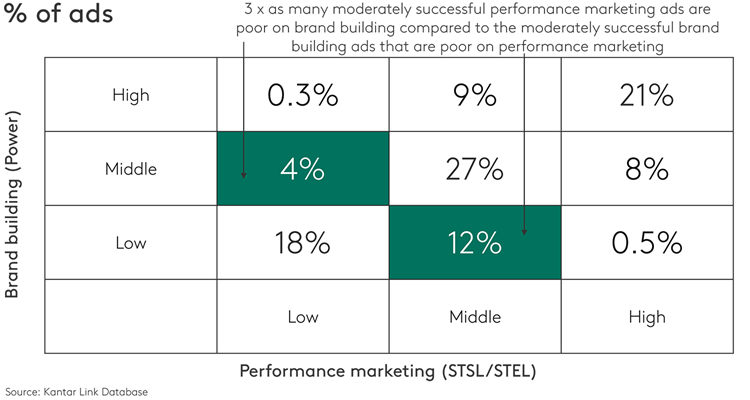
Though it’s not easy, achieving both brand building and performance marketing can be evidenced in examples from our Kantar Creative Effectiveness Award winners over the last four years. Winning ads are selected on metrics relating to not only their overall impact and persuasion (short term sales/effect likelihood), but also their long-term brand building ability to be both meaningful and different.
What are the features of ads that do both well?
Using a dataset of around 50,000 ads researched with consumers over the last five years, we looked at some of the advertising elements seen more prominently in ads that did well on both measures.The ads in the top 5% on both performance marketing and brand building show a slightly higher number of brand variants. We see more continuous showing of the product itself, and more use of product demonstrations, particularly of the product being either used/consumed or showing what it was composed of. We also see greater numbers of ads in this group where the brand appears early on in the ad. Although there was no increased overall use of humour, when it is used, word-play style humour is more evident, a type of humour that we know can help with branding. Similarly, there is no greater overall use of celebrities, but when a celebrity is used, we see more film/movie star celebrities than other types of fame amongst the top ads. Also, although only around 5% of all ads contain environmental or sustainability messages, it is encouraging to see slightly more of these appearing amongst the strongest performing all-round ads.
A focus on brand building is stronger on ROMI profit
We know that not all advertising is always trying to achieve both activation and brand building. Different elements of a campaign may focus on one or the other. But while performance focussed advertising is likely to see a direct increase in ROI, advertising that focuses on brand building is slightly stronger when it comes to ROMI profit.
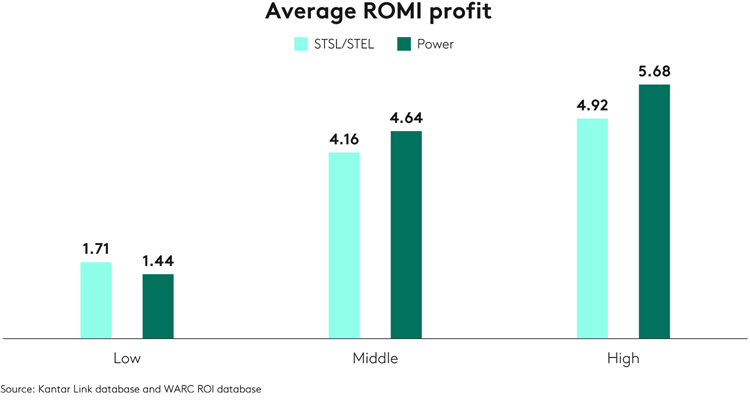
What lies ahead?
Looking ahead, it seems increasingly likely that ads will be able to address both brand and performance in an adaptable and interactive way. Generative AI could see the return of a new type of dynamic content optimisation, which allows the adjustment of advertising in-flight, allowing brand and performance to be more intertwined along with effectiveness measurement. The ability to adjust an ad in real time, such as adding and removing relevant promotions to a brand-building focussed campaign, are leading to the same ads being used in both respects. A great example of a campaign that builds the brand while at the same time successfully engineering sales is McDonald's 'Hungry Eyes'. This ad is not asking for an immediate response (so can be identified as a long one) but it does gently remind us that via the App we can have our favourite McDonalds food delivered straight to our door – a clever way to increase sales.Understanding the performance marketing AND brand building power of all creative units allows brand owners to optimise media laydown in line with the relative importance of their sales and brand-building objectives. Kantar's LINK+ survey-based and Link AI machine-based solutions both provide validated performance marketing and brand building metrics which are perfect for this outcome. The combination of these approaches allows advertisers to rapidly optimise their hero ads using LINK+ while also evaluating all video variants at scale using Link AI.
Kantar can also help when it comes to measuring short and long term effects. Our Unified Marketing Measure and Optimisation (UMMO) solution can provide a fuller mixed measurement of ROI. UMMO is a comprehensive and holistic framework that measures and optimises effectiveness across all marketing channels integrating sales and brand metrics into one predictive system meaning measuring brand building effects is now a much more tangible and accurate prospect.
So, the advertising evolution continues both now and into the future and if you want more guidance from Kantar in how to approach your performance marketing and brand building advertising then do get in touch and find out more about how Kantar can help





